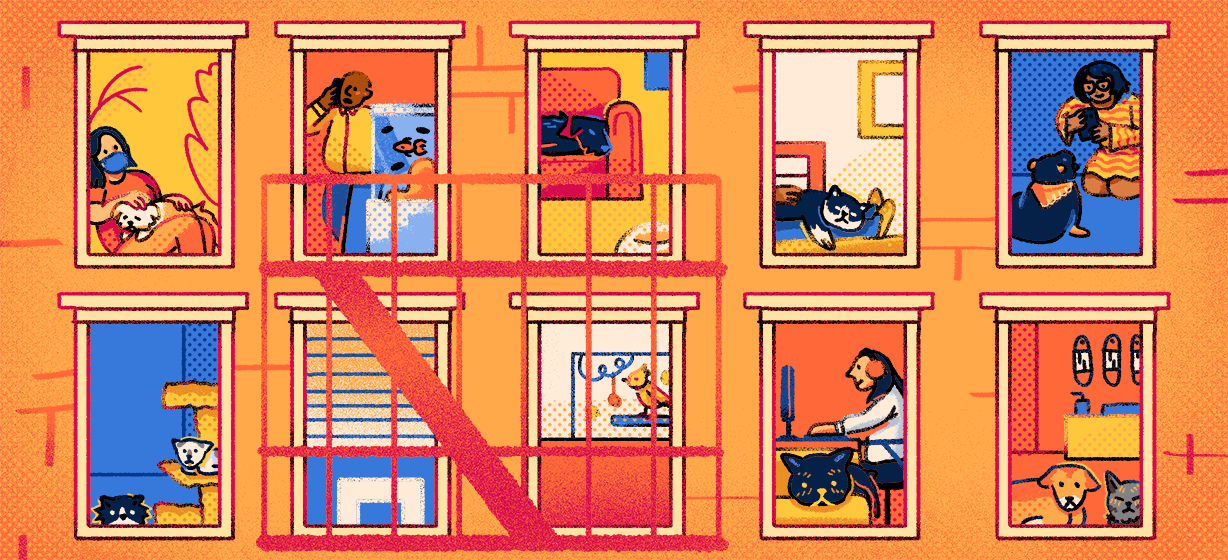To say that 2020 has been a difficult year is an understatement. The COVID pandemic disrupted the lives of millions of Americans, forcing people to spend more time in the confines of their homes.
Many turned this sudden abundance of time at home into an opportunity to do some home improvement, while others, likely missing the company of their friends and colleagues, decided to adopt a pet.
Stories of booming pet adoption around the country made rounds on the internet earlier this year, as good news was in short supply amid anxiety and panic brought about by COVID. We decided to explore the trend further to examine whether pet adoption actually soared during the troublesome year of 2020.
—
Key Findings
- Americans adopted 750,000 animals from shelters since the pandemic began
- Animal adoption rate was at 54%, 3% higher than the year before
- Cats were marginally more likely to get adopted (55% vs 54% for dogs)
- Connecticut was the most active state – 89% of shelter animals were adopted since the start of the COVID pandemic
- Pet adoption was at its lowest in New Mexico, only 39% of shelter animals were adopted
- Dog owners spend $514 a year more on their pet than cat owners
- 83% of pet owners say their pet improves their quality of life during lockdown
—
Adoption Rates Rose during COVID Pandemic, Especially in New England
To keep things simple (and in lieu of data availability), we decided to focus on the two most common pets in America and the world over: cats and dogs.
“54% of shelter animals got adopted—a 3% increase on the previous year.”
According to the data from Shelter Animals Count, over 750,000 cats and dogs were adopted since the start of the COVID pandemic. While that’s lower than 1.16 million in the same period the year before, it’s worth bearing in mind there that the number of animals in the shelters were down 35% this year. Meaning, the adoption rate was indeed higher in 2020. 54% of shelter animals got adopted—a 3% increase on the previous year.
Most of the states that are leading the way in pet adoption in 2020 are in New England. In Connecticut, almost 9 out of 10 (89%) cats and dogs that entered animal shelters since the start of the pandemic were adopted.
In Rhode Island and New Hampshire, the adoption rates were at 82% and 80% respectively, meaning every 4 out of 5 animals that were taken into shelters found a home since the COVID pandemic broke out.
The bottom of the list is largely made up of states in the Southern U.S. Only 39% of pets were adopted in New Mexico, Alabama, and Louisiana—the only three states where adoption rates for cats and dogs were under 40%.
“83% of pet owners said that having a pet helps to reduce their stress and increase their sense of well-being during the COVID-19 pandemic”
—
Dogs in the East, Cats in the West

Which animals were Americans more likely to adopt since the start of the pandemic, cats or dogs? Overall, the answer is cats, but just like in many facets of this enduring debate, it’s close.
More than 55% of cats that were taken in by animal shelters since March 11th were adopted, compared to 54% of dogs. But where are Americans more partial to dogs, and where are cats preferred as companions?
As is the case with many issues, America appears deeply divided on this one. Check the map below to see whether it was cats or dogs people were more likely to adopt in your state.
The East Coast is mostly a dog domain, except the four states in the Northeastern corner of the nation: Massachusetts, Vermont, New Hampshire, and Maine. That’s where cats were more likely to be adopted versus their canine counterparts.
Similarly, the West Coast is cat country, with the exception of the state of Oregon, where dogs saw higher rates of adoption than cats.
“Cats might be ahead of dogs in terms of adoption rates, but it’s dog owners who splash their cash for their pets, outspending cat owners by $514 a year.”
In the Midwest, states like Indiana, Wisconsin and Michigan all favored felines, while Illinois, Ohio and Minnesota were all about the dogs.
Finally, in the states often referred to as the Deep South, people in Mississippi and Alabama clearly preferred to adopt cats, but those in South Carolina, Louisiana and Georgia were more likely to adopt a dog.
To see which states had the highest dog and cat adoption rates, see the table below.
—
Spending on Pets Is on the Rise
Not only have 750,000 Americans adopted a pet since the start of the COVID pandemic, they’re also spending increasingly more money on their furry companions. Quite a feat, considering that for many, the pandemic brought about financial hardship.
Companies like Chewy – a publicly-traded offshoot of PetSmart – recorded their highest-ever revenues this year, peaking with a whopping $1.7 billion in Q3 of 2020. That’s 48% more than Americans spent on pet supplies with this retailer than in the same quarter of 2019.
Cats might be ahead of dogs in terms of adoption rates, but it’s dog owners who splash their cash for their pets, outspending cat owners by $514 a year. As per the findings of the TD Ameritrade survey of pet owners, dog owners outspent cat owners in every category, spending a total of $1,021 annually to cat owners’ $687.
—
A Pet Is Not Just For Lockdown
No surprise that Americans are spending so much more money on their pets.
According to a study by the American Pet Products Association, 83% of pet owners said that having a pet helps to reduce their stress and increase their sense of well-being during the COVID-19 pandemic. For 72% of pet parents, spending time with their cat and/or dog improved their mood during the lockdown. And, the benefits of adopting tend to outweigh shopping for many of these pet owners.
As another wave of COVID cases hits the nation, future lockdowns are likely, meaning it’s is likely people will continue to adopt dogs, cats, or different animals to improve the quality of their home lives.
However, it’s important to remember that once the pandemic subsides (and we sure hope it happens soon), Americans will probably go back to work, start commuting, return to hobbies and resume social life. When that happens, we can only hope their furry friends will continue to hold a special place in their lives, just like they did during the difficult times of COVID lockdowns.
—
Sources and Methodology
The start of the COVID-19 pandemic was taken from its official declaration as a pandemic on March 11th, 2020. Year-on-year comparisons of animal adoption activity between 2020 and 2019 covered the period of March 11th to September 30th.
Pet Adoption Data – ShelterAnimalsCount.org
Pet Spend Data – TD Ameritrade’s Pets & Finances Survey
Pet Attitudes Data – American Pet Products Association via PetFoodIndustry.com
—
Credits
Illustration – Beena Mistry
Research – VK




